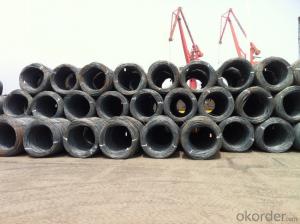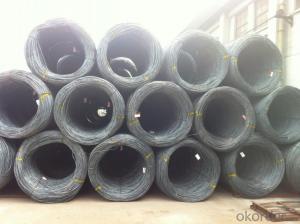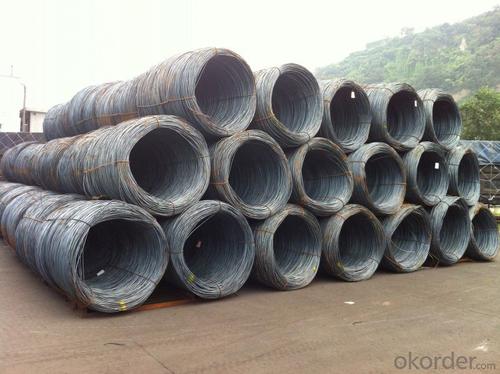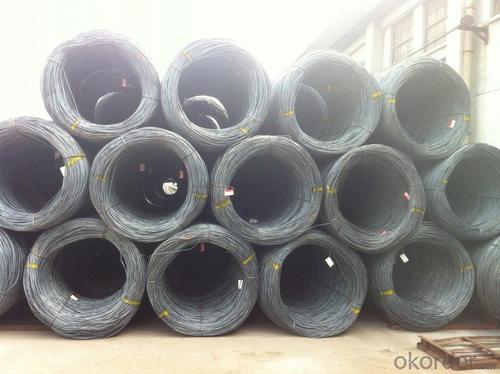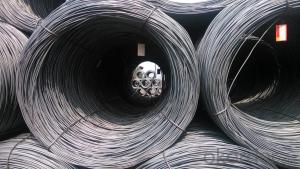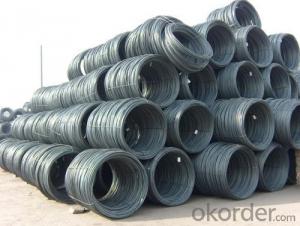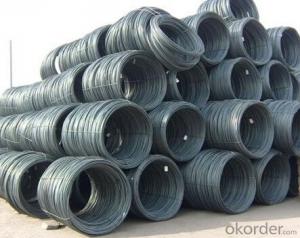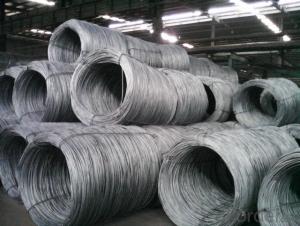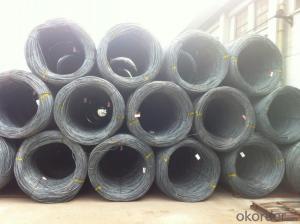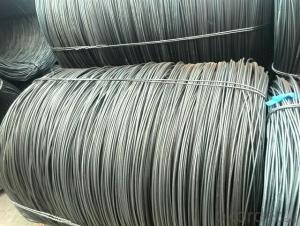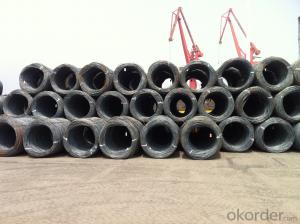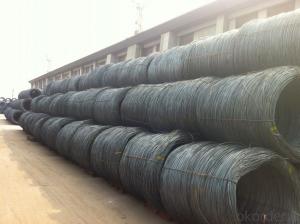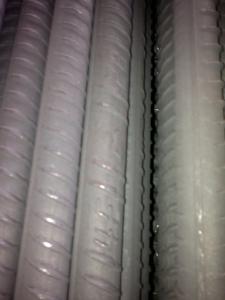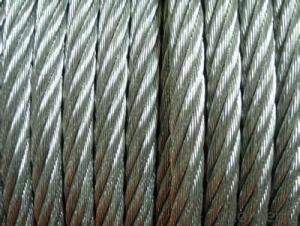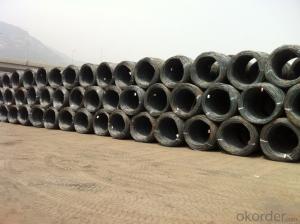Hot Rolled Wire Rods with Good Quality SAE 1008
- Loading Port:
- Tianjin
- Payment Terms:
- TT OR LC
- Min Order Qty:
- 25 m.t.
- Supply Capability:
- 10000 m.t./month
OKorder Service Pledge
OKorder Financial Service
You Might Also Like
Product Description:
OKorder is offering Carbon Steel Wire Rod at great prices with worldwide shipping. Our supplier is a world-class manufacturer of steel, with our products utilized the world over. OKorder annually supplies products to European, North American and Asian markets. We provide quotations within 24 hours of receiving an inquiry and guarantee competitive prices.
Product Applications:
Carbon Steel Wire Rod are ideal for structural applications and are widely used in the construction of buildings and bridges, and the manufacturing, petrochemical, and transportation industries.After hot-rolled the products shaped into coil and delivery as finished product, including round, square, rectangular, hexagonal and so on. Since most of the products are round, it is generally called wire rod. Carbon steel wire rod is widely used in construction and manufacturing. Carbon steel wire rod is mainly used for reinforcement of reinforced concrete and welded structure or reprocessed (roberts , nail, etc.) materials, especially used to produce wire drawing, welding electrode, nails, spring, electronic, precise machinery parts and so on.
Product Advantages:
OKorder's Carbon Steel Wire Rod are durable, strong, and resist corrosion.
Main Product Features:
· Premium quality
· Prompt delivery & seaworthy packing (30 days after receiving deposit)
· Corrosion resistance
· Can be recycled and reused
· Mill test certification
· Professional Service
· Competitive pricing
Product Specifications:
Chemical Composition:
Please kindly find our chemistry of our material based on SAE1006/SAE1008 as below for your information
Grade | Chemical Composition (%) | |||||
C | Mn | S | P | Si | B | |
SAE1006B | 0.03~O.07 | 0.32max | 0.045max | 0.040max | 0.30max | 0.0008min |
Mechanical properties | ||||||
Yield strength(N/mm2) | Tensile strength(N/mm2) | Elongation (%) | ||||
250-280 | 350-380 | ≥32 | ||||
Grade | Chemical Composition (%) | |||||
C | Mn | S | P | Si | B | |
SAE1008B | 0.10max | 0.3~0.50 | 0.050max | 0.040 max | 0.15max | 0.0008 min |
Mechanical properties | ||||||
Yield strength(N/mm2) | Tensile strength(N/mm2) | Elongation (%) | ||||
≥195 | 315-430 | ≥30 | ||||
FAQ:
Q1: Why buy Materials & Equipment from OKorder.com?
A1: All products offered byOKorder.com are carefully selected from China's most reliable manufacturing enterprises. Through its ISO certifications, OKorder.com adheres to the highest standards and a commitment to supply chain safety and customer satisfaction.
Q2: How do we guarantee the quality of our products?
A2: We have established an advanced quality management system which conducts strict quality tests at every step, from raw materials to the final product. At the same time, we provide extensive follow-up service assurances as required.
Q3: How soon can we receive the product after purchase?
A3: Within three days of placing an order, we will begin production. The specific shipping date is dependent upon international and government factors, but is typically 7 to 10 workdays.
Image
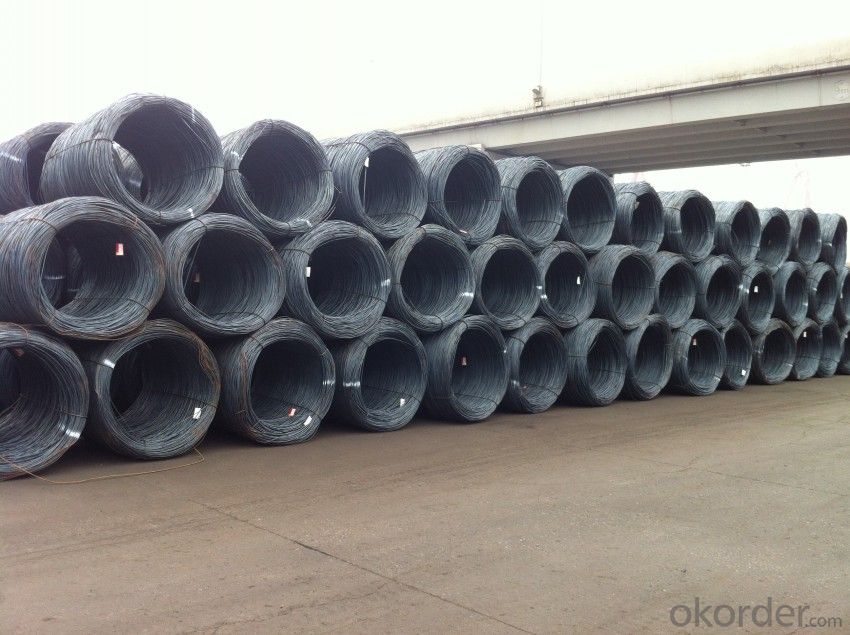
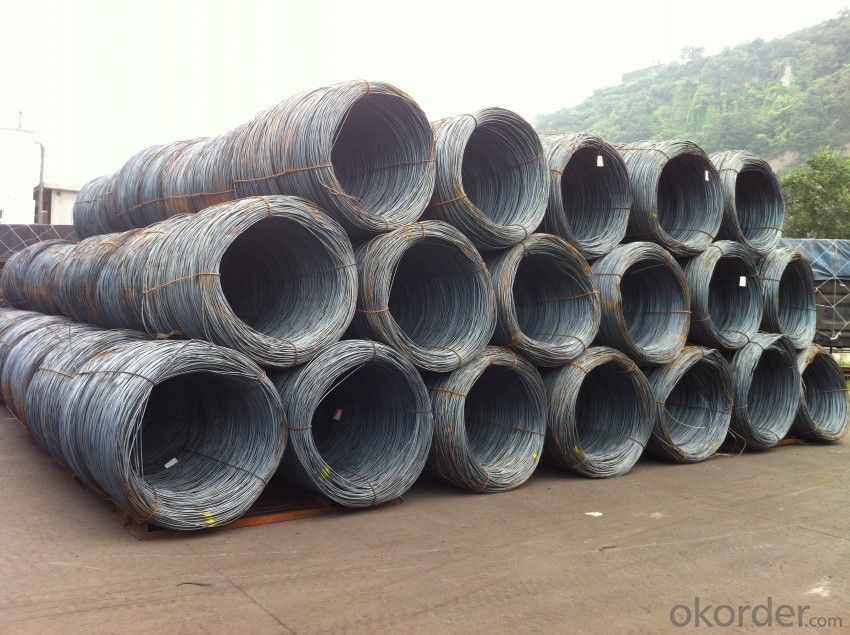
- Q: What are the different types of steel wire rod coatings used for improved ductility?
- Enhancing ductility in steel wire rods involves the utilization of various coatings. These coatings are applied to the surface of the wire rod, serving as a protective layer and improving its mechanical properties. Commonly used coatings include: 1. Zinc Coating: Zinc coatings are extensively utilized for steel wire rods due to their exceptional corrosion resistance and ability to enhance ductility by minimizing the formation of brittle intermetallic compounds. Hot-dip galvanizing, the most prevalent method, involves immersing the wire rod in molten zinc. 2. Copper Coating: Copper coatings are often combined with zinc coatings to provide additional protection against corrosion. Copper aids in enhancing ductility by reducing the formation of brittle phases and improving the wire rod's resistance to cracking during deformation. 3. Phosphate Coating: Steel wire rods are treated with phosphate coatings to enhance lubricity and reduce friction during drawing and forming processes. Moreover, these coatings enhance adhesion between the wire rod and subsequent coatings like zinc or copper. 4. Polymer Coating: Polymer coatings, such as epoxy or polyvinyl chloride (PVC), are employed to establish a protective layer against corrosion and enhance ductility. These coatings function as a barrier, preventing moisture and corrosive substances from penetrating the wire rod and its surroundings. 5. Chromium Coating: Chromium coatings are commonly utilized in high-strength steel wire rods to enhance ductility and minimize the risk of hydrogen embrittlement. These coatings bolster the wire rod's resistance to cracking, thereby enhancing its mechanical properties. It is important to consider that the choice of coating depends on the specific application and desired properties of the steel wire rod. Different coatings offer varying levels of corrosion resistance, lubricity, and adhesion, allowing customization to meet the requirements of diverse industries and applications.
- Q: How is steel wire rod used in the manufacturing of wire forms for fishing nets?
- The manufacturing of wire forms for fishing nets relies heavily on steel wire rod. This essential component undergoes a series of steps to be transformed into a usable wire form. Cleaning, annealing, and drawing processes are employed to achieve the desired diameter and tensile strength. These procedures are crucial in ensuring that the wire possesses the necessary strength and flexibility to withstand the tension and stress it will encounter when used in fishing nets. Once the wire rod has been converted into wire, it is then utilized to fashion the various wire forms needed for fishing nets. These wire forms, including hoops, rings, loops, and connectors, are vital in constructing a functional fishing net. Specialized machinery and techniques, such as bending, cutting, and welding, are employed to create these wire forms according to the specific design requirements. The wire forms are then assembled together to form the structure of the net. The utilization of steel wire rod in the manufacturing of wire forms for fishing nets offers numerous advantages. Steel is renowned for its high strength and durability, making it an ideal material for withstanding the harsh conditions and constant tension experienced by fishing nets. Moreover, steel wire rod is resistant to corrosion, ensuring that the wire forms will have a long lifespan even when exposed to water and other environmental factors. In conclusion, steel wire rod plays a vital role in the manufacturing of wire forms for fishing nets. It serves as the raw material from which the wire forms are created, providing the necessary strength, flexibility, and durability required for a functional fishing net.
- Q: How is steel wire rod used in the production of wire strands for cable-stayed bridges?
- The production of wire strands for cable-stayed bridges relies heavily on steel wire rod. These wire strands are essential for ensuring the bridge's structural stability and load-bearing capacity. To start, steel wire rods are carefully manufactured with specific chemical compositions and mechanical properties to guarantee their suitability for this application. Typically, these wire rods are made from high-strength steel alloys like carbon or alloy steel, which can withstand the immense tension and stress experienced by cable-stayed bridges. The initial stage of the production process involves reducing the diameter of the steel wire rod by drawing it through a series of dies. This process, known as wire drawing, aligns the crystal structure of the steel and eliminates impurities, thereby imparting a higher tensile strength to the wire strand. As a result, the wire strand becomes capable of withstanding significant loads. After the wire strands are formed, they undergo galvanization or coating with a corrosion-resistant material. This protective layer shields the steel from environmental factors like moisture and chemicals, which could cause corrosion and compromise the bridge's integrity. Once the wire strands have been coated, they are assembled into bundles to form the main supporting structure of the cable-stayed bridge. The number of wire strands used, as well as their arrangement and tensioning, depend on the specific design requirements of the bridge. Typically, these wire strands are anchored to the bridge deck and tower, providing support and evenly distributing the load across the structure. The final step involves tensioning the wire strands to their specified levels, ensuring that they can bear the anticipated loads and maintain the stability of the bridge. This tensioning process is crucial for achieving the desired sag and shape of the bridge, as well as evenly distributing the forces among the wire strands. In conclusion, steel wire rod plays a critical role in the production of wire strands for cable-stayed bridges. It provides the necessary strength and durability to withstand the immense loads and forces exerted on these structures. Through various manufacturing processes, the wire rod is transformed into wire strands that are galvanized, bundled, and tensioned to create a stable and reliable supporting system for cable-stayed bridges.
- Q: What are the advantages of using steel wire rod in oil and gas applications?
- There are several advantages of using steel wire rods in oil and gas applications. Firstly, steel wire rods have high tensile strength, which makes them suitable for handling heavy loads and withstanding extreme conditions in the oil and gas industry. Secondly, steel wire rods have excellent corrosion resistance, ensuring a longer lifespan and reducing the need for frequent maintenance. Additionally, steel wire rods offer good flexibility and are easily bendable, allowing for easy installation and maneuverability in complex oil and gas systems. Lastly, steel wire rods have high thermal conductivity, which is crucial for efficient heat transfer in various oil and gas processes.
- Q: What are the different types of steel wire rod surface defect repair methods?
- There are several different types of steel wire rod surface defect repair methods, including grinding, polishing, coating, and heat treatment. Each method is used to address specific types of surface defects, such as scratches, pits, or corrosion. Grinding involves removing the surface layer of the rod to eliminate defects, while polishing smoothens the surface and enhances its appearance. Coating methods, such as electroplating or galvanizing, are used to provide a protective layer against future defects. Heat treatment methods, such as annealing or quenching, can be employed to improve the strength and durability of the wire rod surface. Overall, the choice of repair method depends on the type and severity of the surface defect, as well as the intended application of the steel wire rod.
- Q: How is steel wire rod used in the manufacturing of wire for suspension cables?
- Steel wire rod is a crucial component in the manufacturing of wire for suspension cables. Suspension cables are used in various applications such as bridges, cranes, and even elevator systems. The process of manufacturing wire for suspension cables involves several steps, and steel wire rod plays a critical role in each of these steps. Firstly, the steel wire rod is selected based on its quality and strength properties. It needs to have high tensile strength and excellent ductility to withstand the immense loads and forces that suspension cables are subjected to. The wire rod undergoes a thorough inspection to ensure it meets the required specifications. Next, the steel wire rod is processed through a series of mechanical operations. It is first cleaned and descaled to remove any impurities or surface contaminants. Then, it is heated to a suitable temperature for the subsequent wire drawing process. Heating the wire rod makes it more malleable and easier to deform. After the wire rod is heated, it is drawn through a series of dies to reduce its diameter and increase its length. This wire drawing process involves pulling the heated wire rod through progressively smaller dies, which elongates and thins the wire. This step is crucial in achieving the desired diameter and mechanical properties of the wire. Once the wire has been drawn to the required size, it is further processed to improve its surface finish and mechanical properties. This may involve processes such as annealing, where the wire is heated and slowly cooled to relieve internal stresses and improve its ductility. Finally, the wire is coated or galvanized to enhance its corrosion resistance and protect it from environmental factors. This coating not only improves the longevity of the suspension cables but also enhances their aesthetic appearance. In summary, steel wire rod is used in the manufacturing of wire for suspension cables through a series of mechanical operations. Its high tensile strength and ductility make it suitable for withstanding the heavy loads and forces that suspension cables experience. The wire rod undergoes processes such as cleaning, heating, wire drawing, and coating to achieve the desired diameter, surface finish, and mechanical properties. The end result is a high-quality wire that can be used in various suspension cable applications.
- Q: What are the major steel wire rod producing countries?
- Some of the major steel wire rod producing countries include China, Japan, India, the United States, and Russia.
- Q: How is steel wire rod manufactured?
- Steel wire rod is manufactured through a process called hot rolling, where heated steel billets are passed through a series of rolling stands to gradually reduce their thickness and increase their length. This continuous process ensures uniformity and strength in the wire rod. Once the desired dimensions are achieved, the wire rod is cooled, coiled, and ready for further processing or use in various industries.
- Q: How are steel wire rods used in the production of wire hangers for hanging clothes?
- Steel wire rods are an essential component in the production of wire hangers for hanging clothes. These rods are typically made from high-quality, durable steel, which provides the necessary strength and rigidity to support the weight of garments. The first step in the production process involves cutting the steel wire rods into the desired length for the hangers. This can be done using specialized machinery or through manual cutting methods. Once the rods are cut, they are then bent into the familiar hanger shape, typically using a combination of automated bending machines and skilled workers. The steel wire rods are manipulated and shaped to form the top hook of the hanger, which allows it to be hung on a closet rod or other hanging mechanisms. Additionally, the rods are bent to form the curved body of the hanger, which provides a secure and stable structure for hanging clothes. After the basic shape of the hanger is formed, the steel wire rods may undergo additional processes to improve their functionality and aesthetics. This may include coating the rods with a layer of protective material, such as plastic or vinyl, to prevent rusting and provide a smooth surface for hanging delicate fabrics. The hangers can also be painted or coated with a variety of colors or finishes to match different branding or aesthetic preferences. Overall, steel wire rods play a crucial role in the production of wire hangers for hanging clothes. Their strength, durability, and versatility make them an ideal material for creating hangers that can support a wide range of garments. Whether it's in homes, retail stores, or laundry facilities, wire hangers made from steel wire rods are a staple tool for organizing and displaying clothes.
- Q: How is the ductility of steel wire rod determined?
- Various mechanical tests and measurements determine the ductility of steel wire rod. The tensile test is a commonly used method for evaluating ductility. During this test, a sample of the steel wire rod is pulled until it fractures, and the amount of deformation it undergoes before breaking is measured. Throughout the tensile test, the steel wire rod experiences an increasing load or force, while its elongation or deformation is continuously measured. The force needed to stretch the wire to a specific length is recorded, and a stress-strain curve is created. The stress-strain curve provides information about the ductility of the steel wire rod. The elongation or deformation at the point of fracture is a crucial parameter for assessing its ductility. A higher elongation indicates greater ductility because it means the material can withstand more deformation before breaking. In addition to the tensile test, other tests like the bend test and impact test can also evaluate the ductility of steel wire rod. During the bend test, the wire is bent to a specific angle without fracturing. The ability to bend without breaking shows good ductility. Similarly, the impact test measures the energy absorbed by the wire when it experiences a sudden impact. Higher energy absorption suggests better ductility because it means the material can absorb and distribute the impact forces without fracturing. In conclusion, the ductility of steel wire rod is determined through mechanical tests like the tensile test, bend test, and impact test. These tests assess the wire's deformation capabilities, its ability to bend without breaking, and its energy absorption during impact, respectively.
Send your message to us
Hot Rolled Wire Rods with Good Quality SAE 1008
- Loading Port:
- Tianjin
- Payment Terms:
- TT OR LC
- Min Order Qty:
- 25 m.t.
- Supply Capability:
- 10000 m.t./month
OKorder Service Pledge
OKorder Financial Service
Similar products
Hot products
Hot Searches
Related keywords

